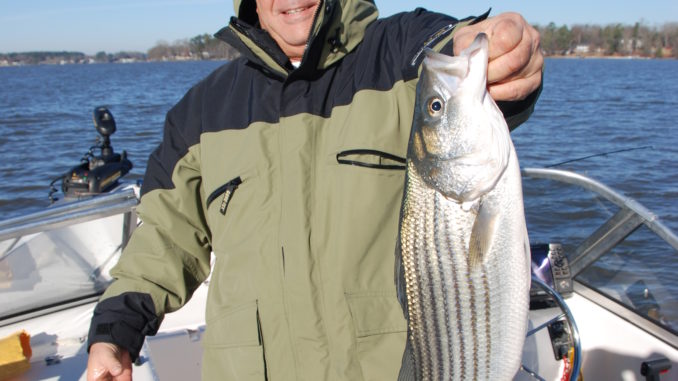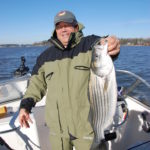
Know where to look and how to fish live baits, and Lake Murray’s winter stripers may become your favorite targets.
Most people would consider a cold, dreary day in February a terrible time to be outside, much less on the water fishing. But that sentiment doesn’t hold true for Mike Gault of Jonesville, S.C. A retired game warden, he looks forward to the nastiest days of the year so he can head to South Carolina’s Lake Murray and drag live baits behind the boat for striped bass.
Murray’s striper fishery has been something of a roller-coaster ride. Years ago, it was so good, all an angler had to do was drop a live bait straight down practically anywhere in sight of SC 6. Then came a decline as the fishery gained popularity and biologists struggled with summer fishing mortality, aquatic weed control, establishing creel and size limits that would balance out the fishing pressure.
“When the state enacted the ‘five-and-done’ rule (Only five stripers can be kept from July through September), I was able to see a difference in the quality of the fish in just the last three to four years,” said Gault, who owns a home on Murray and fishes there two to three times a week.
Murray was turning into a success story of how an engineered fish could be successfully managed as a put-grow-and-take fishery in a man-made impoundment when dead stripers showed up floating at the end of last summer.
“It’s going to be interesting to see what the creel surveys tell our biologists this year,” Gault said, “to see if the fish kill had an impact on … fish from 18 to 24 inches, which were mainly the size we saw floating down around the dam back in August.”
That area won’t be where Gault is concentrating in February. Most of the late-winter action, he said, is from the Dreher Island area at mid-lake up to the SC 391 bridges across the Big Saluda and Little Saluda rivers.
“The wintertime pattern is in full swing,” said Gault. “Fish will be scattered from mid-lake all the way up the river above the two bridges. Live bait, using free lines and planer boards, works well during this time of year, along with casting artificial baits. A lot of anglers (will be) casting bucktails with ice flies and swim baits under the birds. You’ll see birds working one area — seagulls and loons — feeding on the shad, and the stripers tend to be up under those birds.”
And with stripers actually thriving in cooler water, this isn’t a deep-water fishery. Gault does the majority of his bait-dragging in less than 15 feet of water.
“I pull planer boards in 5 feet of water, and we’ll catch some quality fish in February and March,” he said. “They’ll be up there in those shallows, in the back of the creeks, and we’ll pull boards across shallow points anywhere from 3 to 10 foot (deep) and often catch some real quality fish.”
“Free lines” is a term often used by striper fishermen, because they’re often used by them. The term generally refers to using no weight in front of a live bait, although it is not unusual to tie a barrel swivel between the main line and a short section of leader. Free-line fishing also refers to trailing lines straight back from the rod to the bait or using a planer board to drag the bait out to the side of the boat. A typical deployment may have a couple of free lines behind the boat and several planer boards staggered out on either side.
“You want your baits to be swimming natural as they can swim and out of sight of the board,” Gault said. “We like to troll using a bow-mounted electric trolling motor, moving anywhere from .5 to .6 mph. Now, if we’re seeing a lot of suspended fish in 25 to 30 feet of water, I might put a split-shot on the line to try to get that bait down just a little bit, but in shallow water, you put that bait back there about 20 feet behind your planer board, and he’s going to be down just under the water a couple of feet.”
When it comes to live bait, the choice is typically between blueback herring and gizzard shad. Bluebacks have wide appeal among striper fishermen but top out in available sizes from local bait shops at around 5 to 6 inches. Gizzard shad on the other hand, can be tailored by size to target either keeper-sized striped bass or bigger, trophy fish.
Chip Bragg of Columbia, S.C., one of the administrators on the Lake Murray Fishing Reports Facebook page and a veteran striper fisherman, said gizzard shad are his hands-down favorite, and the bigger, the better.
“Gizzard shad spawn in shallow water, and they spawn pretty early, as soon as the water temps start coming up,” Bragg said. “I believe that’s one reason you’ll find bigger stripers in such shallow water from this time of year on through April.
Gault’s preference is a 6- to 7-inch gizzard shad, a morsel that will appeal to stripers that barely exceed the 21-inch size minimim, as well as the bigger specimens. Bragg has a hard time using anything under 10 inches long and prefers a 12- to 14-inch bait, if can catch some in his cast net.
“I’m okay with trolling all day for only one or two bites,” Bragg said. “If you are looking to catch a limit of fish, the smaller gizzards work well along with blueback herring, but the bigger baits will weed the smaller fish out. It’s just a matter of what you’re looking to catch.”
Bragg finds a gizzard shad’s length not as imposing to stripers as a bait’s girth. He said male shad are skinnier and not as tall as females, and that plays a major role in how he rigs for them.
“I will run a big nose-hook in a long, skinny male shad,” said Bragg. “It seems to me that the taller females will get hit and mauled first before the striper gets it in its mouth. In those cases, I will rig a stinger hook in the hopes of getting a better hookset, sometimes on the side of the head when the fish first slams the bait.”
DESTINATION INFORMATION
HOW TO GET THERE — Lake Murray lies roughly between I-20 and I-26, west of Columbia. On the upper end of the 50,000-acre lake, US 378 between Lexington and Saluda is the key to accessing popular ramps: Lake Murray Estates Park, Riverbend Point, Lake Murray Shores. Visit www.lakemurrayfun.com/ramps.shtml.
BEST TECHNIQUES — Late-winter striper fishing on Lake Murray falls into two major categories: trolling with live bait and casting artificial baits to schooling fish. The majority of fish will be found in the mid-lake area from Dreher Island up to the SC 391 Bridge crossings on the Big Saluda and Little Saluda rivers.Anglers will catch fish trolling live gizzard shad or blueback herring from .5 to .6 miles per hour on free lines and behind planerboards. Target shallow flats and long, shallow points looking for ambush spots where stripers will feed on a naturally presented live bait. Artificial bait anglers will find better success looking for diving birds working the surface of the water. Gulls and loons typically shadow schools of stripers that push the bait to the surface. A bucktail/ice fly combination is very popular at Lake Murray as well as swim baits, flukes, and Alabama rigs.
FISHING INFO/GUIDES — Ben Lee, Capt. Ben’s Fishing Adventures, 803-730-5627; Brad Taylor, 803-331-1354, www.tayloroutdoors.com; Lake Murray Fishing Reports, www.facebook.com/Lake-Murray-Fishing-Reports. See also Guides and Charters in Classifieds.
ACCOMMODATIONS — Capital City/Lake Murray Country, 866-SC-JEWEL, www.lakemurraycountry.com.
MAPS — Navionics Electronic charts, 800-848-5896, www.navionics.com. Delorme S.C. Atlas and Gazetteer, 800-561-5105, www.delorme.com; Fishing Hot Spots, 800-ALL-MAPS, www.fishinghotspots.com; Kingfisher Maps, 800-326-0257, www.kfmaps.com.





Be the first to comment